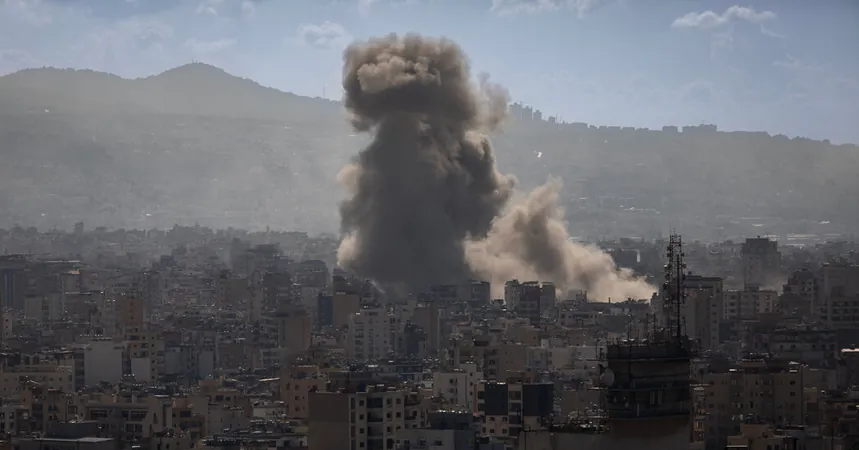
Escalating Tensions as Israel Targets Hezbollah in Southern Lebanon: Medics Among Casualties
2024-11-16
Author: Jia
Increase in Israeli Airstrikes in Southern Lebanon
The Israeli military has intensified its bombardment in southern Lebanon, particularly around the Dahiya area near Beirut, which is heavily controlled by Hezbollah, the Shiite militia. On Saturday, airstrikes reportedly resulted in the tragic deaths of two paramedics, stirring outrage within Lebanon's community, as highlighted by the nation’s health ministry.
Casualties and Condemnations
Throughout the day, multiple airstrikes rattled the Dahiya district, leading to significant blasts that were felt in the heart of Beirut. The Israeli military claims that these targeted strikes are directed at facilities linked to Hezbollah, alleging that the group is concealing “terrorist infrastructure” within civilian neighborhoods. This approach marks one of the most intense periods of aerial bombardment seen in this region since the conflict escalated.
Impact on Medical Personnel
There is a growing chorus of condemnation from the Lebanese public and officials regarding the increasing toll on medical responders during the conflict. Lebanon's health ministry has referred to the deaths of rescue workers as “barbaric attacks” and has called on the international community to uphold humanitarian laws amidst the ongoing violence. Alarmingly, the past week alone has seen nearly two dozen rescue workers killed, with over 145 healthcare professionals losing their lives since the outbreak of the war in mid-September, according to data provided by the World Health Organization (WHO).
International Response and Reactions
In one instance, a paramedic was killed in Kfar Tibnit, with other team members reportedly missing in the aftermath. The WHO's director general, Tedros Adhanom Ghebreyesus, has also condemned the fatalities, particularly a devastating airstrike that targeted emergency workers in Douris, which has drawn international scrutiny.
Hezbollah's Retaliation
Simultaneously, Hezbollah has ramped up its retaliatory measures, launching new drone and rocket strikes against northern Israel, further escalating the conflict. Israeli defense systems reportedly intercepted many of these projectiles, resulting in spectacular midair explosions over cities like Haifa.
Broader Regional Dynamics
This recent surge in warfare is deeply intertwined with the broader regional dynamics and complexities. Since last October, Hezbollah has engaged in near-daily attacks on Israel, acting in solidarity with their allies in Gaza, exacerbating the ongoing conflict. Following a major ground invasion by Israel into Lebanon on October 1, the humanitarian situation has dramatically worsened, displacing around a million Lebanese citizens and causing tens of thousands of Israelis to flee their homes due to the rocket threats.
Diplomatic Efforts for Cease-Fire
As U.S. diplomats try to mediate a cease-fire, the situation remains precarious. The Biden administration has renewed efforts to negotiate peace; however, both Hezbollah and Iran have shown little willingness to acquiesce to Israeli demands that include withdrawing troops from the border.
Potential Shifts in Negotiations
Iranian sources close to the negotiations hinted at a potential shift, suggesting that the supreme leader has advised Hezbollah to align with a cease-fire agreement consistent with U.N. Security Council resolution 1701, which previously aimed to stabilize the region. Nevertheless, Lebanese parliament speaker Nabil Berri voiced skepticism regarding a recent American proposal, labeling some aspects as unacceptable to the Lebanese government.
Conclusion and Future Outlook
The stakes continue to escalate as both sides remain entrenched in their positions, with the potential for broader ramifications that could impact regional stability. As the conflict rages on, the international community watches closely, hoping for a resolution before human suffering deepens.

 Brasil (PT)
Brasil (PT)
 Canada (EN)
Canada (EN)
 Chile (ES)
Chile (ES)
 España (ES)
España (ES)
 France (FR)
France (FR)
 Hong Kong (EN)
Hong Kong (EN)
 Italia (IT)
Italia (IT)
 日本 (JA)
日本 (JA)
 Magyarország (HU)
Magyarország (HU)
 Norge (NO)
Norge (NO)
 Polska (PL)
Polska (PL)
 Schweiz (DE)
Schweiz (DE)
 Singapore (EN)
Singapore (EN)
 Sverige (SV)
Sverige (SV)
 Suomi (FI)
Suomi (FI)
 Türkiye (TR)
Türkiye (TR)